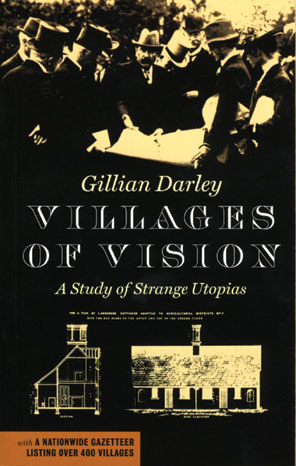I would find it difficult to forget Milton Abbas. Cycling through the West Country with friends some years ago – on this particular day in the teeming rain – we stopped at the village tea-room for toasted sandwiches and coffee. Miraculously the sky cleared while our little party was eating and drying out, and we emerged into a fairytale confection of sunlit thatched cottages, as if painted by Helen Allingham or Kate Greenaway. As Gillian Darley points out in this engaging history of utopian settlements in Britain, there were hundreds more where that one came from.
 First published in 1975, Darley’s history of model communities – ranging from almshouses to Tolstoyan anarchist colonies, agricultural communes to modernist industrial experiments such as that at Silver End in Essex – is happily in print again. It provides an essential travelling companion to those who like to roam the back-lanes of history and geography for alternative stories of how people have tried to live differently. John Stuart Mill once said that any truly free society had to make room for a variety of “experiments in living”, and Darley’s book remains a unique study of such experiments in Britain.
First published in 1975, Darley’s history of model communities – ranging from almshouses to Tolstoyan anarchist colonies, agricultural communes to modernist industrial experiments such as that at Silver End in Essex – is happily in print again. It provides an essential travelling companion to those who like to roam the back-lanes of history and geography for alternative stories of how people have tried to live differently. John Stuart Mill once said that any truly free society had to make room for a variety of “experiments in living”, and Darley’s book remains a unique study of such experiments in Britain.
Despite its Arcadian appearance, Milton Abbas was in fact a ruthless exercise in social engineering. In order to get better views of the countryside from the great house and estate, a “sizeable market town with its own grammar school, almshouses, shops, four inns, brewery”, along with many houses, was demolished and the pretty new village created in a cleft in the downs, out of sight. These early model villages served several purposes, not only providing housing for loyal estate workers and elderly retainers, but also creating an elegant grace-note in the landscape to the great house and its picturesque setting.
Many were designed from architectural pattern books – here’s one I made earlier – and the form and design motifs of the rustic village have endured as an expression of communitarian idealism ever since. Later attempts to produce model rural communities after Milton Abbas were made of sterner stuff, with ideas of equality and fraternity firing the visions of those such as the Owenites or Chartists, who wanted to build settlements where everybody earned the full value of their labour and shared what surplus they had. Never was architecture more moralised than in the designs for these circular settlements or, at their worst, barracks-style fastnesses, in which political principles were firmly laid down in perpetuity in bricks and mortar (alas, too often to little effect).
The ideal of the self-sufficient community, where beauty, economy and social harmony intertwine, never goes away. Even the worst of modern British housing borrows references from the rustic tradition – barge-boarding, dormer windows, bucolic street names – though any social ideals have been stripped out along with the craft detailing. Where idealism not only continues, and indeed is expanding, is in collective provision for the elderly. In this new edition, Darley mentions the largely self-managed retirement village of New Earswick in York, and interestingly this was also visited and described in detail in Tobias Jones’s recent foray into communal living, Utopian Dreams (2007).
The British landscape is dotted with remnants of these fascinating and often heroic social experiments, and the extensive county-by-county gazetteer provided by Darley is an invaluable reference guide. To some extent elements of this utopian tradition continued in the postwar holiday camp, and even more recently in places such as Center-Parcs, where cars are prohibited, and a degree of environmental education is built into the scheme of things. The recent announcement by Gordon Brown of ten new “eco-towns” provides another reminder that new social ideas sooner or later have to find architectural form.
To borrow from William Carlos Williams: “No ideas but in things” (or places).
Villages of Vision is published by Five Leaves Press

